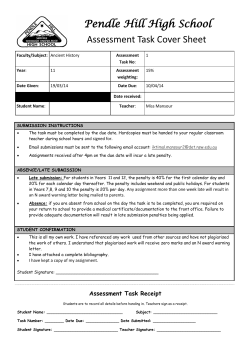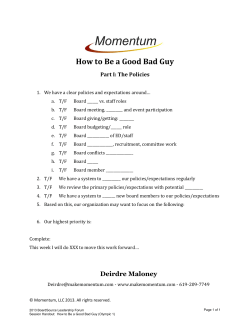
Bill Nye the Science Guy - the Museum of Ontario Archaeology
Grade Level Overall Goals of the Lesson The Ontario Curriculum 2013 Social Studies Grades 1 to 6 Grades 4-6 Duration 30 minutes Students will watch the archaeology episode of Bill Bye the Science Guy and answer the questions on the student handout. Overall Expectations Grade 4 – Strand A A1. Application: Compare key aspects of life in a few early societies (3000 BCE-1500 CE), each from a different region and era and representing a different culture, and describe some key similarities and differences between these early societies and present-day Canadian society. A2. Inquiry: Use the social studies inquiry process to investigate ways of life and relationships with the environment in two or more early societies (3000 BCE-1500 CE), with an emphasis on aspects of the interrelationship between the environment and life in those societies. A3. Understanding Context: Demonstrate an understanding of key aspects of a few early societies (3000 BCE-1500 CE), each from a different region and era and representing a different culture, with reference to their political and social organization, daily life, and relationships with the environment and with each other. Grade 5 – Strand A A3. Understanding Context: Describe significant features of and interactions between some of the main communities in Canada prior to 1713, with a particular focus on First Nations and New France. Required Materials Prerequisites Main Activity Grade 6 – Strand B B2. Inquiry: Use the social studies inquiry process to investigate some global issues of political, social, economic, and/or environmental importance, their impact on the global community, and responses to the issues. Bill Nye the Science Guy, Archaeology Episode: https://www.youtube.com/watch?v=HgWmpUfzLAU Bill Nye the Science Guy – Student Handout Bill Nye the Science Guy – Teacher Handout This activity can be done before or after participating in the MOA educational programs. 1. Students will watch the Bill Nye the Science Guy Archaeology episode and complete the questions provided on the student handout. 2. When the video is done, the class will take up the answers. Source: https://www.youtube.com/watch?v=HgWmpUfzLAU 1. What is archaeology? Answer is found at 1:25. Archaeology is the study of ancient people and their culture. 2. What is the name for the small objects archaeologists find? Answer is found at 1:47. Artifacts – in Latin this means “made with skill.” 3. What does an archaeologist do when they discover an artifact? Answer is found at 2:00. They have to unbury them. When the artifact is exposed they keep careful records of exactly where the artifact was found. Leave an artifact right where you found it because where it was found can tell us about how the artifact was used. Scientists collect these artifacts and store them in a museum. 4. Explain what happens when an archaeologist finds an artifact that is broken. Answer is found at 4:20-5:15. By putting the broken pieces back together, archaeologists can try to figure out how it was broken and used. After the pieces were excavated and cleaned, each piece was catalogued and labeled. So the artifact can be perfectly reconstructed. By reassembling the fragments, archaeologists can reconstruct the big picture. 5. How are garbage piles used in archaeology? Answer is found at 5:40-6:25. The oldest stuff is on the bottom, and the newer stuff is on the top. Studying what people threw out can tell us a lot about how they lived. 6. How do archaeologists know a pot is 5,000 years old? Answer is found at 8:30-10:28. Scientists use radiocarbon dating. Every living thing has a lot of carbon in them. Carbon 14 (radio carbon) is slightly radioactive, making it unstable, so it breaks down into Carbon 12. While a living thing is alive, the ratio of Carbon 14 and Carbon 12 remains the same. As soon as the living thing dies the Carbon 14 slowly goes away. Archaeologists can date an artifact by how much Carbon 14 remains. With the pot, archaeologists date the carbon residue (baked on food) left in the pot. 7. What was the Rosetta Stone? Answer is found at 10:50-11:54. In Ancient Egypt they used symbols, called hieroglyphics, which stood for a sound representing an idea. As languages evolved no one could understand what the images meant. In 1799 French archaeologists found a stone tablet that had Greek, Egyptian, and hieroglyphs. They used the Greek and Egyptian languages to understand the hieroglyphic images. 8. Why is garbage a great place for archaeologists to look? What is it called? Answer is found at 14:00-15:30. Garbage is a snapshot of what was really going on because people don’t think about their garbage before they throw it out. Garbage heaps are called middens. By digging things up, archaeologists try to answer: who was here? When they were here? What tools they have? Did they have contact with people from Europe? 1. What is archaeology? 2. What is the name for the small objects archaeologists find? 3. What does an archaeologist do when they discover an artifact? 4. Explain what happens when an archaeologist finds an artifact that is broken. 5. How are garbage piles used in archaeology? 6. How do archaeologists know a pot is 5,000 years old? 7. What is the Rosetta Stone? 8. Why is garbage a great place for archaeologists to look? What is it called?
© Copyright 2025












